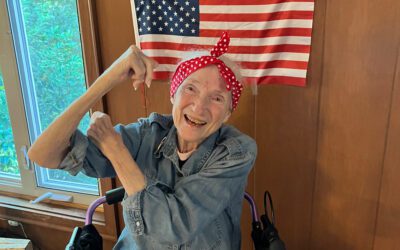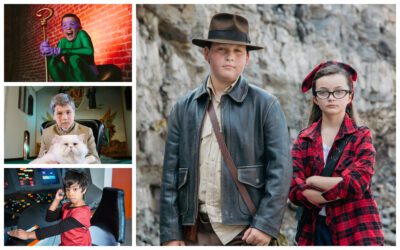[title subtitle=”words: Marla Cantrell
images: Ken Fry photo courtesy Ken Fry via Heritage Portraits. Sunset courtesy Ken Fry”][/title]
Kenneth (Ken) Fry sits inside the bookstore Chapters on Main in Van Buren, Arkansas, just four days before his retirement as editor for the Press Argus-Courier, the twice-weekly paper covering Crawford County. He is wearing a light windbreaker even though the temperature dropped to forty-four degrees today. He takes a drink of his coffee—Americano, no cream, no sugar—before he speaks.
The first question he answers is how was he able to complete a fifty-two-year career with such a favorable reputation. Ken smiles and says, “My mama taught me to treat people like you want to be treated.”
I learned to treat people the way I wanted to be treated from my mama, I got my work ethic from my dad.
In all these years, talking to those in power and those in trouble, he exercised respect.
While his reputation is important to him, he doesn’t take credit for much else. He was taught by the best, beginning with his Van Buren High School journalism teacher, Mary Maude Gallagher. He’d taken her class in 1966, his senior year, thinking it might be an easy grade. But Mary, brand new to the job, started putting out a serious newspaper.
At home, the lessons multiplied. Ken’s dad, Leroy, was the editor for the morning edition of the now-Times Record (there was also an afternoon edition at that time), and someone Ken both dearly loved and admired.
With graduation looming, Ken enrolled in Westark (now UAFS) and asked his dad for a part-time job, but he wouldn’t hire him. Instead, he sent him to talk to General Manager Ross Pendergraft, who was more than ready to take a chance on another Fry. Armed with a pay slip that said he’d earn $1.30 an hour, he went back to his dad’s office.
“Dad took a look at the slip and said, ‘Minimum wage is $1.25 an hour, and you don’t have any experience,’” Ken says. “He took a pen and marked through the 30 to change it to 25.
“I was going to start after graduation on Friday, and I asked for a week off. Dad said, ‘I’ll give you Saturday night. Be at work on Sunday.’
“I learned to treat people the way I wanted to be treated from my mama, I got my work ethic from my dad.”
For the first three years, Ken worked on the copy desk, editing and writing headlines on the night shift. He became a reporter after that, and in 1973, added afternoon news editor to his list of duties.
The first big story Ken covered happened on April 19, 1968, when he arrived at work wearing his Sunday best. He’d been told he’d get off early to celebrate his twentieth birthday. But that afternoon, an F4 tornado hit Greenwood, killing fourteen. The paper sent Ken and photographer Henry Barnett to see what they could find. They passed an uninjured state trooper whose car had been blown over, and he tried to stop them. Ken and Henry kept going, realizing they were the only journalists who would make it to the scene before authorities showed up to run them out.
Ken remembers the heart-dropping photos Henry took. He remembers talking to people who were stunned and grateful to be alive. He remembers ruining his birthday shoes.
Over the years, he’s covered the influx of more than 50,000 Vietnamese refugees to Fort Chaffee beginning in 1975, an event that made national news. In May 1980, more than 19,000 refugees from Fidel Castro’s infamous Muriel Boatlift, landed at Fort Chaffee, and on June 1, a Sunday when Ken was at Kerr Lake, a riot broke out at Chaffee, injuring sixty-two refugees and leading to the arrest of forty-six others.
When he got home, he had multiple phone messages from his dad telling him to get to work.
While those stories are intriguing, he also remembers details that highlight a past era, including the influence of one of the iconic department stores that has since closed. “At Thanksgiving, the Boston Store would buy a sixteen-page section filled with full-page ads. People would line up at 920 Rogers Avenue trying to talk a carrier out of a newspaper. They’d stand in their yards waiting for that paper to be thrown.”
After Ken’s stint at the Times Record, he freelanced, even working as a wedding photographer for a time.
In 1992, he joined the staff of the Press Argus-Courier, and in 1997 he became the editor.
A story that stands out is the shooting at the Crawford County Courthouse on September 13, 2011. It happened just after the Wednesday Press Argus-Courier had been printed. “One of our distribution guys said there’d been a shooting and [reporter] Taniah Tudor and I took off.”
An armed man looking for Judge Gary Cottrell, shot administrative assistant Vickie Jones in the leg after she told him the judge was not in. The gunman then shot at offices on the first floor, shattering glass doors, tearing through historic photographs that lined the walls, and causing terror in those hiding from his wrath.
The shooter was killed by police. The courthouse has since installed new safety measures.
Speaking of the coverage, he said, “Vickie and I are friends, and she talked to me for our Saturday paper. But that day, we threw all the newspapers away and printed a new edition. We won a Press Association award for that.”
Having a job where you cover tragic events that happen to people you care about is part of the territory, but doesn’t make it any easier. Beyond the tragedy were stories that made his career a happy one. Ken loved sharing stories of kids winning spelling bees, the high school teams that went to state championships, the champions who brought new life to downtown Van Buren or took on the restoration of historic Fairview Cemetery. Speaking of the Press Argus-Courier, he says, “You win with the positive stories.” And that statement seems to represent him perfectly.
In 2012, he was given the Iverson Riggs Citizen of the Year Award. Each year, Ken had been told beforehand who’d won so he could have his story ready. The committee told him the winner was Maryl Koeth (now Purvis), director of the Van Buren A&P. When he arrived at the ceremony and heard the introduction, he realized the award was for him. Maryl, who was in on the deception, was delighted by Ken’s surprise.
One section of the paper that he never turned over to anyone else was the obituaries. He understood how important they were, and he wrote them carefully, aware of the grieving families who expected them to be right. Jenny McClure, a brilliant co-worker and friend, called to confirm details. There was no excuse for error.
Through the years he’s collected a raft of friends, like Cecil Harlan, who once owned Tri-State Speedway. Ken, a self-confessed workaholic, did PR for the track on the side for thirty years, and the two remained buddies until Cecil’s death from ALS in 2011. “He was the best friend I ever had,” Ken says.
Living in the world of news requires a way to decompress. For Ken, it was his little place on Chicken Creek at Lake Tenkiller, where he still goes nearly every weekend with his wife, Sandy. His Facebook feed brightens with photos of sunsets there, like fire on water.
He also has supper once a week with his stepmom, Lucy Fry, who still writes for the Times Record, and can’t imagine what he’d do without her care and advice. “I just love her to death,” Ken says.
Once he thought he’d never retire and someone he trusted said he’d know when it was time. Not so long ago, he realized the time had come, and now he’s looking forward to being a regular citizen who gets up each morning, walks his three dogs, and doesn’t worry about the next deadline.
Ken smiles again, imagining a life at the lake, on the beach, anywhere his feet can take him. It’s impossible to know what stories will unfold there, but it’s safe to say they’ll all be expertly written.




